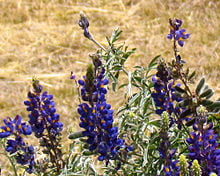Lupinus mutabilis

Lupinus mutabilis is a species of lupin grown in the Andes, mainly for its edible bean. Vernacular names include tarwi[2] (tarhui), chocho, altramuz, Andean lupin, South American lupin, Peruvian field lupin, and pearl lupin.[3] Its nutrient-rich seeds are high in protein, as well as a good source for cooking oil. However, their bitter taste has made L. mutabilis relatively unknown outside the Andes, though modern technology makes it easier to remove the bitter alkaloids.[3] Like other species of lupin beans, it is expanding in use as a plant-based protein source.[4]
The origin of L. mutabilis has been identified in the Andean region of Ecuador, Peru and Bolivia.[5] In this area, the greatest genetic variability in the world was found. The plant has been domesticated for more than 1500 years, mostly because of its high protein content.[3]
L. mutabilis is an annual plant. The stem is hollow and highly branched. Plant height reaches from 0.5 to 2.8 meters, depending on the environmental conditions and the genomic properties. Due to the high vegetative growth, species from northern South America are taller than species from the southern Andean region.[6] The genome contains 2n = 48 chromosomes and there is a high genomic variation, which leads to big differences in morphology. Several architectural types of L. mutabilis exist. Most common is the branching in V-form, this type has the highest biomass production. The basal branching type has the positive feature that its infructescence is at the same level. This species is preferably promoted because of its early ripening, stability and the homogeny seed quality.[6]
